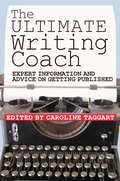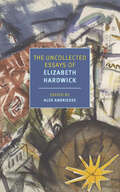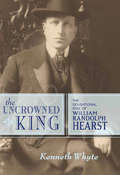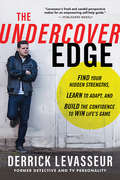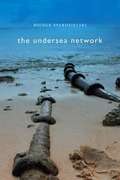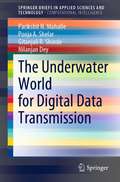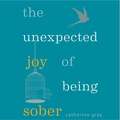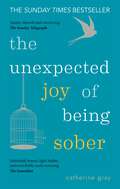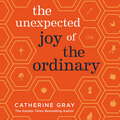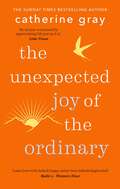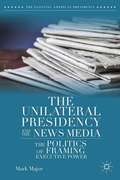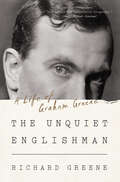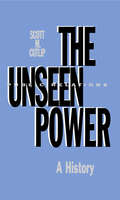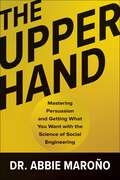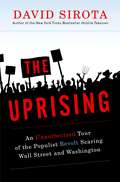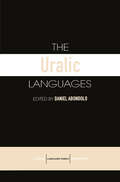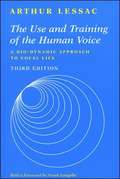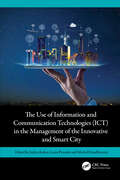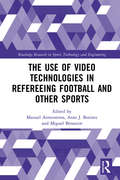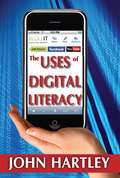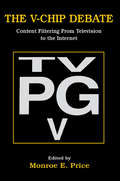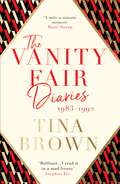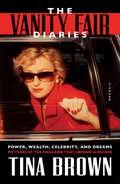- Table View
- List View
The Ultimate Writing Coach: Expert Information and Advice on Getting Published
by Caroline TaggartThe Ultimate Writing Coach contains everything you need to know about writing and publishing. It presents authoritative guidance direct from professional writers covering the full gamut of both the fiction and non-fiction market. For fiction, there is coaching on everything from creating believable characters and writing short stories to specialist subjects such as crime and children's fiction. For non-fiction learn from expert advice on travel and technical writing, writing for the web, poetry and biographical writing, and journalism. This invaluable guide also includes succinct, practical guidance on actually getting published, with articles on how to get your submission right for immediate impact, contracts and legal issues, and the financial side.There are handy tips on learning opportunities, whether you're a high school graduate looking to embark on a university degree or a full-time mom looking to take a short course or workshop. And a handy glossary of book trade terminology will ensure you're fully clued up on your industry jargon.
The Uncollected Essays of Elizabeth Hardwick
by Elizabeth HardwickEssays on music, art, pop culture, literature, and politics by the renowned essayist and observer of contemporary life, now collected together for the first time. The Uncollected Essays of Elizabeth Hardwick is a companion collection to The Collected Essays, a book that proved a revelation of what, for many, had been an open secret: that Elizabeth Hardwick was one of the great American literary critics, and an extraordinary stylist in her own right. The thirty-five pieces that Alex Andriesse has gathered here—none previously featured in volumes of Hardwick&’s work—make it clear that her powers extended far beyond literary criticism, encompassing a vast range of subjects, from New York City to Faye Dunaway, from Wagner&’s Parsifal to Leonardo da Vinci&’s inventions, and from the pleasures of summertime to grits soufflé. In these often surprising, always well-wrought essays, we see Hardwick&’s passion for people and places, her politics, her thoughts on feminism, and her ability, especially from the 1970s on, to write well about seemingly anything.
The Uncrowned King: The Sensational Rise of William Randolph Hearst
by Kenneth WhyteA lively, unexpected, and impeccably researched piece of popular history, The Uncrowned King reveals how an unheralded young newspaperman from San Francisco arrived in New York and created the most successful daily of his time, pushing the medium to an unprecedented level of influence and excitement, and leading observers to wonder if newspapers might be "the greatest force in civilization," more powerful even than kings and popes and presidents.Featuring an eight-page insert of black and white photographs, The Uncrowned King offers a window onto the media world at the turn of the 19th century, as seen by its most successful and controversial figure, William Randolph Hearst. Kenneth Whyte's anecdotal, narrative style chronicles Hearst's rivalry with Joseph Pulitzer, the undisputed king of New York journalism, in the most spectacular newspaper war of all time. They battled head-to-head for three years, through the thrilling presidential election campaign of 1896 and the Spanish-American War-a conflict that Hearst was accused of fomenting and that he covered in person. By 1898, Hearst had supplanted Pulitzer as the dominant force in New York publishing, and was well on his way to becoming one of the most powerful and fascinating private citizens in 20th-century America.
The Undercover Edge: Find Your Hidden Strengths, Learn to Adapt, and Build the Confidence to Win Life's Game
by Derrick LevasseurIn a televised social experiment before millions of viewers, police sergeant Derrick Levasseur demonstrated that techniques used by undercover detectives could help people achieve their goals in everyday social situations. The result: he walked away with more than half a million dollars.In The Undercover Edge, Derrick shares his personal mind-set surrounding human behavior and motivation. Even more than that, he provides easy yet groundbreaking tools acquired while overcoming personal adversity and working more than a decade in law enforcement, showing readers: The power of observation and creating a profile The effect of using silence to extract and evaluate information The benefits of interpreting body language and developing your sixth sense The importance of self-awareness and adapting to your environment The value of developing a personal ops plan with a defined missionDerrick's approach allows readers to create a solid foundation in their lives, build confidence personally and professionally, and push themselves to become stronger, more capable leaders.
The Undersea Network
by Nicole StarosielskiIn our "wireless" world it is easy to take the importance of the undersea cable systems for granted, but the stakes of their successful operation are huge, as they are responsible for carrying almost all transoceanic Internet traffic. In The Undersea Network Nicole Starosielski follows these cables from the ocean depths to their landing zones on the sandy beaches of the South Pacific, bringing them to the surface of media scholarship and making visible the materiality of the wired network. In doing so, she charts the cable network's cultural, historical, geographic and environmental dimensions. Starosielski argues that the environments the cables occupy are historical and political realms, where the network and the connections it enables are made possible by the deliberate negotiation and manipulation of technology, culture, politics and geography. Accompanying the book is an interactive digital mapping project, where readers can trace cable routes, view photographs and archival materials, and read stories about the island cable hubs.
The Underwater World for Digital Data Transmission (SpringerBriefs in Applied Sciences and Technology)
by Nilanjan Dey Parikshit N. Mahalle Gitanjali R. Shinde Pooja A. ShelarThis book covers all small details about Underwater Sensor Networks (UWSN). Researchers can use this book as a prerequisite before starting any research on underwater networks or underwater applications. This book covers the introduction, challenges, different architectural models for UWSN, various attacks on UWSN, underwater applications, and networking layers. The target audience includes professors and students in engineering, and researchers and engineers working on marine applications. In academic level, the book is helpful for students having Networking and Information Security as elective subject and doing projects in Wireless Networks. It is also helpful for spostgraduates and Ph.D. researchers to learn basics of Underwater Sensor Networks.
The Unexpected Joy of Being Sober: THE SUNDAY TIMES BESTSELLER
by Catherine GrayTHE SUNDAY TIMES BESTSELLER 'Gray's tale of going sober is uplifting and inspiring' - The Evening Standard 'An icon of the Quit Lit movement' - Condé Nast Traveller 'Fascinating' - Bryony Gordon 'Not remotely preachy' - The Times 'Jaunty, shrewd and convincing' - Sunday Telegraph 'Admirably honest, light, bubbly and remarkably rarely annoying' - Alice O'Keeffe, Guardian 'Truthful, modern and real' - Stylist 'Brave, witty and brilliantly written' - Marie Claire 'The Unexpected Joy of Being Sober came to me at a time when I much needed it... The book became my best friend, and got me through, and took me on a journey.' - Sadie Frost 'Particularly lovely, because it's not a deep and dark dive into someone's terrible addiction. It's a celebration of everything that she has gained from not drinking' - Laura Donnelly Ever sworn off alcohol for a month and found yourself drinking by the 7th? Think there's 'no point' in just one drink? Welcome! There are millions of us. 64% of Brits want to drink less.Catherine Gray was stuck in a hellish whirligig of Drink, Make horrible decisions, Hangover, Repeat. She had her fair share of 'drunk tank' jail cells and topless-in-a-hot-tub misadventures.But this book goes beyond the binges and blackouts to deep-dive into uncharted territory: What happens after you quit drinking? This gripping, heart-breaking and witty book takes us down the rabbit-hole of an alternative reality. A life with zero hangovers, through sober weddings, sex, Christmases and breakups.In The Unexpected Joy of Being Sober, Catherine Gray shines a light on society's drink-pushing and talks to top neuroscientists and psychologists about why we drink, delving into the science behind what it does to our brains and bodies.Much more than a tale from the netherworld of addicted drinking, this book is about the escape, and why a sober life can be more intoxicating than you ever imagined. Whether you're a hopelessly devoted drinker, merely sober-curious, or you've already ditched the drink, you will love this book. 'Haunting, admirable and enlightening' - The Pool 'A riveting, raw, yet humorous memoir with actionable advice. A truly unique blend of storytelling and science that holds a universe of hope.' - Annie Grace, author of This Naked Mind 'Like listening to your best friend teach you to be sober. Lighthearted but serious, it's packed with ideas, tools, tips and, most importantly, reasons for living a sober life. This book is excellent.'- Eric Zimmer, host of podcast The One You Feed 'Gray's fizzy writing succeeds in making this potentially boring-as-hell subject both engaging and highly seductive' - The Bookseller 'Catherine Gray is an exceptional writer. Her exquisitely crafted thoughts on the joys of being sober are not only deeply honest and pragmatic, but she manages to infuse tons of humor. This is a delightful, informative, and compelling read for all those who are sober or seeking sobriety.' - Sasha Tozzi, Huffington Post columnist 'Catherine's writing style and voice captivate me. She has a way of translating her story into an experience I don't want to end. I want to drink every drop she produces.' - Holly Whitaker, founder of Hip Sobriety School and co-presenter of Home podcast 'This book is great. A balanced, informative and entertaining mélange of memoir, sociology and psychology. I identified very strongly with huge sections of it.' - Jon Stewart, guitari
The Unexpected Joy of Being Sober: THE SUNDAY TIMES BESTSELLER (The Unexpected Joy Of #1)
by Catherine GrayGoing sober will make you happier, healthier, wealthier, slimmer and sexier. Despite all of these upsides, it's easier said than done. This inspirational, aspirational and highly relatable narrative champions the benefits of sobriety; combining the author's personal experience, factual reportage, contributions from experts and self-help advice.
The Unexpected Joy of Being Sober: THE SUNDAY TIMES BESTSELLER (The Unexpected Joy Of #1)
by Catherine GrayGoing sober will make you happier, healthier, wealthier, slimmer and sexier. Despite all of these upsides, it's easier said than done. This inspirational, aspirational and highly relatable narrative champions the benefits of sobriety; combining the author's personal experience, factual reportage, contributions from experts and self-help advice.
The Unexpected Joy of the Ordinary
by Catherine Gray**From the Sunday Times Bestselling Author**We're told that happiness is in the extraordinary. It's on a Caribbean sun lounger, in the driving seat of a luxury car, inside an expensive golden locket, watching sunrise from Machu Picchu. We strive, reach, push, shoot for more. 'Enough' is a moving target we never quite reach.When we do brush our fingertips against the extraordinary a deeply inconvenient psychological phenomenon called the 'hedonic treadmill' means that, after a surge of joy, our happiness level returns to the baseline it was at before the 'extra' event.So, what's the answer? The Unexpected Joy of the Ordinary theorises that the solution is rediscovering the joy in the ordinary that we so often now forget to feel. Because we now expect the pleasure of a croissant, a hot shower, a yoga class, someone delivering our shopping to our door, we no longer feel its buzz. The joy of it whips through us like a bullet train, without pause.Catherine Gray was a grandmaster in the art of eye-rolling the ordinary, and skilled in everlasting reaching. Until the black dog of depression forced her to re-think everything.Along the way, she discovered some surprising realities about the extraordinaries among us: that influencers risk higher rates of anxiety and depression, high-rollers are less happy, and huge frothy weddings increase the likelihood of divorce.Learning how to be exalted by the everyday is the most important lesson we can possibly learn. In Catherine Gray's hilarious, insightful, soulful (and very ordinary) next book, you may learn to do just that.PRAISE FOR CATHERINE GRAY'S WRITING:"Fascinating" Bryony Gordon."Not remotely preachy" The Times"Jaunty, shrewd and convincing" The Telegraph "Admirably honest, light, bubbly and remarkably rarely annoying" The Guardian(p) 2019 Octopus Publishing Group
The Unexpected Joy of the Ordinary (The Unexpected Joy Of #4)
by Catherine Gray**From the Sunday Times Bestselling Author**Life-affirming - THE TELEGRAPHWonderful - INDEPENDENTShe made it her mission to learn how to be default happy rather than default disgruntled - RADIO 4 - WOMAN'S HOURTake a leaf out of Gray's book and be kinder to yourself by appreciating life just as it is - IRISH TIMESThis book came to me in an hour of need - during lockdown when I had to focus on the positive, appreciate simple things, not lose my shit, and value each day. It was a pure joy for me and held my hand - SADIE FROSTInteresting and joyful. Lights a path that could help us to build resilience against society's urging to compare life milestones with peers - LANCET PSYCHIATRY Underwhelmed by your ordinary existence? Disillusioned with your middlin' wage, average body, 'bijou' living situation and imperfect loved ones? Welcome to the club. There are billions of us. The 'default disenchanted'. But, it's not us being brats. Two deeply inconvenient psychological phenomenons conspire against our satisfaction. We have negatively-biased brains, which zoom like doom-drones in on what's wrong with our day, rather than what's right. (Back in the mists of time, this negative bias saved our skins, but now it just makes us anxious). Also, something called the 'hedonic treadmill' means we eternally quest for better, faster, more, like someone stuck on a dystopian, never-ending treadmill. Thankfully, there are scientifically-proven ways in which we can train our brains to be more positive-seeking. And to take a rest from this tireless pursuit. Whew.Catherine Gray knits together illuminating science and hilarious storytelling, unveiling captivating research showing that big bucks don't mean big happiness, extraordinary experiences have a 'comedown' and budget weddings predict a lower chance of divorce. She reminds us what an average body actually is, reveals that exercising for weight loss means we do less exercise, and explores the modern tendency to not just try to keep up with the Murphys, but keep up with the Mega-Murphies (see: the social media elite).Come on in to this soulful and life-affirming read, to discover why an ordinary life may well be the most satisfying one of all.
The Unexpected Joy of the Ordinary (The Unexpected Joy Of #4)
by Catherine Gray**From the Sunday Times Bestselling Author**Life-affirming - THE TELEGRAPHWonderful - INDEPENDENTShe made it her mission to learn how to be default happy rather than default disgruntled - RADIO 4 - WOMAN'S HOURTake a leaf out of Gray's book and be kinder to yourself by appreciating life just as it is - IRISH TIMESThis book came to me in an hour of need - during lockdown when I had to focus on the positive, appreciate simple things, not lose my shit, and value each day. It was a pure joy for me and held my hand - SADIE FROSTInteresting and joyful. Lights a path that could help us to build resilience against society's urging to compare life milestones with peers - LANCET PSYCHIATRY Underwhelmed by your ordinary existence? Disillusioned with your middlin' wage, average body, 'bijou' living situation and imperfect loved ones? Welcome to the club. There are billions of us. The 'default disenchanted'. But, it's not us being brats. Two deeply inconvenient psychological phenomenons conspire against our satisfaction. We have negatively-biased brains, which zoom like doom-drones in on what's wrong with our day, rather than what's right. (Back in the mists of time, this negative bias saved our skins, but now it just makes us anxious). Also, something called the 'hedonic treadmill' means we eternally quest for better, faster, more, like someone stuck on a dystopian, never-ending treadmill. Thankfully, there are scientifically-proven ways in which we can train our brains to be more positive-seeking. And to take a rest from this tireless pursuit. Whew.Catherine Gray knits together illuminating science and hilarious storytelling, unveiling captivating research showing that big bucks don't mean big happiness, extraordinary experiences have a 'comedown' and budget weddings predict a lower chance of divorce. She reminds us what an average body actually is, reveals that exercising for weight loss means we do less exercise, and explores the modern tendency to not just try to keep up with the Murphys, but keep up with the Mega-Murphies (see: the social media elite).Come on in to this soulful and life-affirming read, to discover why an ordinary life may well be the most satisfying one of all.
The Unilateral Presidency and the News Media
by Mark MajorMedia coverage of presidential actions can not only serve journalistic purposes, but can also act as a check against unilateral decision making. The book seeks to uncover how the news media has worked to curtail overreaching power within the executive branch, demonstrating how the fourth estate keeps presidential overreach at bay.
The Unquiet Englishman: A Life Of Graham Greene
by Richard GreeneA vivid, deeply researched account of the tumultuous life of one of the twentieth century’s greatest novelists, the author of The End of the Affair. One of the most celebrated British writers of his generation, Graham Greene’s own story was as strange and compelling as those he told of Pinkie the Mobster, Harry Lime, or the Whisky Priest. A journalist and MI6 officer, Greene sought out the inner narratives of war and politics across the world; he witnessed the Second World War, the Vietnam War, the Mau Mau Rebellion, the rise of Fidel Castro, and the guerrilla wars of Central America. His classic novels, including The Heart of the Matter and The Quiet American, are only pieces of a career that reads like a primer on the twentieth century itself. The Unquiet Englishman braids the narratives of Greene’s extraordinary life. It portrays a man who was traumatized as an adolescent and later suffered a mental illness that brought him to the point of suicide on several occasions; it tells the story of a restless traveler and unfailing advocate for human rights exploring troubled places around the world, a man who struggled to believe in God and yet found himself described as a great Catholic writer; it reveals a private life in which love almost always ended in ruin, alongside a larger story of politicians, battlefields, and spies. Above all, The Unquiet Englishman shows us a brilliant novelist mastering his craft. A work of wit, insight, and compassion, this new biography of Graham Greene, the first undertaken in a generation, responds to the many thousands of pages of letters that have recently come to light and to new memoirs by those who knew him best. It deals sensitively with questions of private life, sex, and mental illness, and sheds new light on one of the foremost modern writers.
The Unseen Power: A History (Routledge Communication Series)
by Scott M. CutlipBased largely on primary sources, this book presents the first detailed history of public relations from 1900 through the 1960s. The author utilized the personal papers of John Price Jones, Ivy L. Lee, Harry Bruno, William Baldwin III, John W. Hill, Earl Newsom as well as extensive interviews -- conducted by the author himself -- with Pendleton Dudley, T.J. Ross, Edward L. Bernays, Harry Bruno, William Baldwin, and more. Consequently, the book provides practitioners, scholars, and students with a realistic inside view of the way public relations has developed and been practiced in the United States since its beginnings in mid-1900. For example, the book tells how: * President Roosevelt's reforms of the Square Deal brought the first publicity agencies to the nation's capital. * Edward L. Bernays, Ivy Lee, and Albert Lasker made it socially acceptable for women to smoke in the 1920s. * William Baldwin III saved the now traditional Macy's Thanksgiving Day parade in its infancy. * Ben Sonnenberg took Pepperidge Farm bread from a small town Connecticut bakery to the nation's supermarket shelves -- and made millions doing it. * Two Atlanta publicists, Edward Clark and Bessie Tyler, took a defunct Atlanta bottle club, the Ku Klux Klan, in 1920 and boomed it into a hate organization of three million members in three years, and made themselves rich in the process. * Earl Newsom failed to turn mighty General Motors around when it was besieged by Ralph Nader and Congressional advocates of auto safety. This book documents the tremendous role public relations practitioners play in our nation's economic, social, and political affairs -- a role that goes generally unseen and unobserved by the average citizen whose life is affected in so many ways by the some 150,000 public relations practitioners.
The Upper Hand: Mastering Persuasion and Getting What You Want with the Science of Social Engineering
by Dr. Abbie MaroñoLearn to get what you want from others and build stronger relationships by replacing coercive tactics with this social science-backed playbook for winning trust. Having leverage—in the form of intelligence, charm, beauty, money, status, or insider knowledge—often gives you an advantage in an interaction. When it doesn&’t, or when you don&’t have any, people often turn to tricks and schemes that run the risk of damaging personal relationships. In The Upper Hand human behavioral scientist and sought-after speaker, advisor, and coach Dr. Abbie Maroño shows you how to influence people and situations in your favor with skill and integrity—and without the need for leverage or coercion. Based on principles of prosocial engineering, Dr. Abbie shows you how to build and maintain trust by gaining an understanding of the psychological mechanisms underpinning human decision making. She presents five key truths about the complexity of human behavior that you can count on one hand to give you the upper hand: we are our brains we are driven to survive (by any means necessary) we want to connect and cooperate we have a mind-body feedback loop we want to protect our self-identity By grasping how these truths are at play—and learning to see how they show up differently based on cultural contexts, individual differences, and situational dynamics—you&’ll be primed to tailor an informed approach to influencing outcomes when it matters most. Personal connections are key to getting what we want—whether moving up in our careers, attracting customers, or maintaining romantic partnerships. The Upper Hand is your indispensable guide to building trust and cooperation on your way to getting what you want, whatever it may be.
The Uprising: An Unauthorized Tour of the Populist Revolt Scaring Wall Street and Washington
by David Sirota[From the book jacket] An All-Access Pass to the Populist Insurrection Brewing Across the Country Job outsourcing. Perpetual busy signals at government agencies. Slashed paychecks. Stolen elections. A war without end, fatally mismanaged. Ordinary Americans on both the Right and Left are tired of being disenfranchised by corrupt politicians of both parties and are organizing to change the status quo. In his invigorating new book, David Sirota investigates whether this uprising can be transformed into a unified, lasting political movement. Throughout the course of American history, uprisings like the one we are seeing now have given birth to powerful movements to end wars, protect workers, and expand civil rights, so the prospect of today's uprising turning into a full- fledged populist movement terrifies Wall Street and Washington. In The Uprising, Sirota takes us far from the national media spotlight into the trenches where real change is happening - from the headquarters of the most powerful third party in America to the bowels of the U.S. Senate; from the auditorium of an ExxonMobil shareholder meeting to the quasi-military staging area of a vigilante force on the Mexican border. This is vital, on-the-ground reporting that immerses us in the tumultuous give-and-take of politics at its most personal. Sirota also offers a biting critique of our politics. He shows how the uprising is, at its core, a reaction to faux "bipartisanship" in the nation's capital - the "bipartisanship" whereby Republican and Democratic lawmakers join together in putting the agenda of corporate interests above all those of ordinary citizens. Ultimately, Sirota reminds us that the Declaration of Independence, "America's original uprising manifesto," says that governments "derive their powers from the consent of the governed." Irreverent and insightful, The Uprising shows how the governed have stopped consenting and have started taking action.
The Uralic Languages (Routledge Language Family Series)
by Daniel AbondoloThis book provides a unique, up-to-date survey of individual Uralic languages and sub-groupings from Finnish to Selkup.Spoken by more than 25 million native speakers, the Uralic languages have important cultural and social significance in Northern and Eastern Europe, as well as in immigrant communitites throughout Europe and North America. The introductory chapter gives an overview of the Uralic language family and is followed by 18 chapter-length descriptions of each language or sub-grouping, giving an analysis of their history and development as well as focusing on their linguistic structures.Written by internationally recognised experts and based on the most recent scholarship available, the volume covers major languages - including the official national languages of Estonia, Finland and Hungary - and rarely-covered languages such as Mordva, Nganasan and Khanty. The 18 language chapters are similarly-structured, designed for comparative study and cover phonology, morphology, syntax and lexicon. Those on individual languages also have sample text where available. Each chapter includes numerous tables to support and illustrate the text and bibliographies of the major references for each language to aid further study. The volume is comprehensively indexed.This book will be invaluable to language students, experts requiring concise but thorough information on related languages and anyone working in historical, typological and comparative linguistics.
The Use And Training Of The Human Voice: A Bio-dynamic Approach To Vocal Life
by Frank Langella Arthur LessacThis introductory text details Arthur Lessac’s proven procedures for understanding, training, and improving the voice and speech of the performer by exploring the varied qualities of the physical energies associated with producing sounds.
The Use of Information and Communication Technologies (ICT) in the Management of the Innovative and Smart City
by Judyta Kabus Luiza Piersiala Michał DziadkiewiczKey elements in the formation of smart cities are development based on cooperation between local governments and business, the realization of sustainable development goals, the creation of social sustainability, the advancement of information and communication technologies (ICT) and the use of innovative solutions. The theories of information and communication have become the main driver of economic development in a globalized world and the information component plays a key role in building the competitive potential of countries and cities.The purpose of this book is to systematize knowledge about the practical application and importance of innovative solutions in the economic and social fields. An important aspect of this edition is the presentation of innovations applied in the field of conservation, not only of energy or environmental resources, but also of economic, social and spatial resources. We propose that this edition provides a knowledge base on the basic concepts of corporate social responsibility (CSR), formulating the important role of management in the context of CSR, smart management, smart economy and smart cities.The book is a comprehensive study of the smart city concept in its broadest sense, covering environmental, social and economic issues.It will be helpful to professionals in companies, in logistics departments and in the management teams. It can be useful for practitioners and analysts in the transportation industry to expand applications of ICT solutions. It will also be valuable to researchers, doctoral students of economics in management and entrepreneurship, logistics, as well as students at the advanced level, as it brings a range of valuable information that can serve as base material and reference for further research, programmes and studies.
The Use of Video Technologies in Refereeing Football and Other Sports (Routledge Research in Sports Technology and Engineering)
by Manuel Armenteros Anto J. Benitez Miguel Ángel BetancorFor a long time, various different lobbying sectors have claimed that the use of video technology is an effective aid in decision-making. Now the IFAB has taken a historic step in the approval of experiments on the use of video to provide support to football refereeing. The Use of Video Technologies in Refereeing Football and Other Sports analyses the capacity of audio-visual technology from different perspectives to help understand the best implementation of the Video Assistant Referee (VAR) system in football and, more generally, in other sports. This book addresses in-depth interdisciplinary viewpoints on the need and the opportunity of the implementation procedures regarding how to use it, considering that it could lead to very important changes. The book goes on to examine various approaches to the most interesting topics for players, amateurs, coaches, referees and referees coaches. Offering viewpoints from both academics and professionals, this new volume addresses the VAR issue in a multidisciplinary way, analysing the implications of video replay application in football from the perspective of players, coaches, television professionals, referees, amateurs, sports lawyers, media and educators.
The Uses of Digital Literacy (Creative Economy + Innovation Culture Ser.)
by John HartleyAt the heart of this book lies a reappraisal of humanities research and its use in understanding the conditions of a consumer-led society. This is an open, investigative, critical, scientific task as well as an opportunity to engage with creative enterprise and culture. Now that every user is a publisher, consumption needs to be rethought as action not behavior, and media consumption as a mode of literacy.Online social networks and participatory media are often still ignored by professionals, denounced in the press and banned in schools. But the potential of digital literacy should not be underestimated. Fifty years after Richard Hoggart's pioneering The Uses of Literacy reshaped the educational response to popular culture, John Hartley extends Hoggart's argument into digital media. Media evolution has made possible the realism of the modern age journalism, the novel and science not to mention mass entertainment on a global scale.Hartley reassesses the historical and global context, commercial and cultural dynamics and the potential of popular productivity through analysis of the use of digital media in various domains, including creative industries, digital storytelling, YouTube, journalism, and mediated fashion. Encouraging mass participation in the evolutionary growth of knowledge, The Uses of Digital Literacy shows how today's teenage fad may become tomorrow's scientific method. Hartley claims the time has come for education to catch up with entertainment and for the professionals to learn from popular culture. This book will stimulate the imagination and stir further research.
The V-chip Debate: Content Filtering From Television To the Internet (Routledge Communication Series)
by Monroe E. PriceThe V-chip is a highly significant part of the discussion about whether television (or broadcasting in general) deserves some special attention in terms of its accessibility to children, its particular power to affect conduct, and its invasiveness. But as this notion of filtering and labeling has caught the imagination of the regulator, the legislator, and all those who wish to consider new ways to alter bargaining over imagery in society, the very idea of the V-chip or its equivalent is moving across other technologies, including the Internet. The V-chip issue has also fueled the ongoing debate about violence and sexual practices in society, and how representations on television relate to those practices. Although the initial concept of the V-chip is simple, its flow into the public realm raises so many extraordinary questions that the introduction and production of the chip virtually serves as a case study in problems of law and public policy. The very conceptualization of speech in society is being affected by this issue. Accordingly, the place of the V-chip in this debate is increasingly important; indeed, it may be argued that the V-chip's contribution to legal argumentation may be greater than its ultimate contribution to the relationship between children and imagery. Among the questions the contributors address are: *What research basis is necessary to require a framework for labeling and rating? *What relationship between government and the image-producing industries can be characterized--for constitutional and other reasons--as voluntary as opposed to coercive? *Who should evaluate these images? *To what extent should the evaluation process be centralized and/or distributed? *What assessment is appropriate to evaluate whether the experiment is "successful?" In addition to the V-chip's origin's in Canada and its further evolution in the United States, this book discusses the development of the V-chip and television rating systems in Europe, Australia, and throughout the world. It also includes essays which contrast the very different approaches in Canada and the United States in terms of the role of regulatory agency, industry, and government.
The Vanity Fair Diaries: 1983 - 1992
by Tina Brown'Indiscreet, brilliantly observed, frequently hilarious' Evening Standard'Hang on - it's a wild ride' Meryl StreepIt's 1983. A young Englishwoman arrives in Manhattan on a mission. Summoned in the hope that she can save Condé Nast's troubled new flagship Vanity Fair, Tina Brown is plunged into the maelstrom of competitive New York media. She survives the politics and the intrigue by a simple stratagem: succeeding. Here are the inside stories of the scoops and covers that sold millions: the Reagan kiss, the meltdown of Princess Diana's marriage to Prince Charles, the sensational Annie Leibovitz cover of a gloriously pregnant, naked Demi Moore. Written with dash and verve, the diary is also a sharply observed account of New York and London society. In its cinematic pages the drama, comedy and struggle of raising a family and running an 'it' magazine come to life.
The Vanity Fair Diaries: 1983 - 1992
by Tina BrownNamed one of the best books of 2017 by Time, People, The Guardian, Paste Magazine, The Economist, Entertainment Weekly, & VogueTina Brown kept delicious daily diaries throughout her eight spectacular years as editor-in-chief of Vanity Fair. Today they provide an incendiary portrait of the flash and dash and power brokering of the Excessive Eighties in New York and Hollywood.The Vanity Fair Diaries is the story of an Englishwoman barely out of her twenties who arrives in New York City with a dream. Summoned from London in hopes that she can save Condé Nast's troubled new flagship Vanity Fair, Tina Brown is immediately plunged into the maelstrom of the competitive New York media world and the backstabbing rivalries at the court of the planet's slickest, most glamour-focused magazine company. She survives the politics, the intrigue, and the attempts to derail her by a simple stratagem: succeeding. In the face of rampant skepticism, she triumphantly reinvents a failing magazine.Here are the inside stories of Vanity Fair scoops and covers that sold millions—the Reagan kiss, the meltdown of Princess Diana's marriage to Prince Charles, the sensational Annie Leibovitz cover of a gloriously pregnant, naked Demi Moore. In the diary's cinematic pages, the drama, the comedy, and the struggle of running an "it" magazine come to life. Brown's Vanity Fair Diaries is also a woman's journey, of making a home in a new country and of the deep bonds with her husband, their prematurely born son, and their daughter.Astute, open-hearted, often riotously funny, Tina Brown's The Vanity Fair Diaries is a compulsively fascinating and intimate chronicle of a woman's life in a glittering era.
